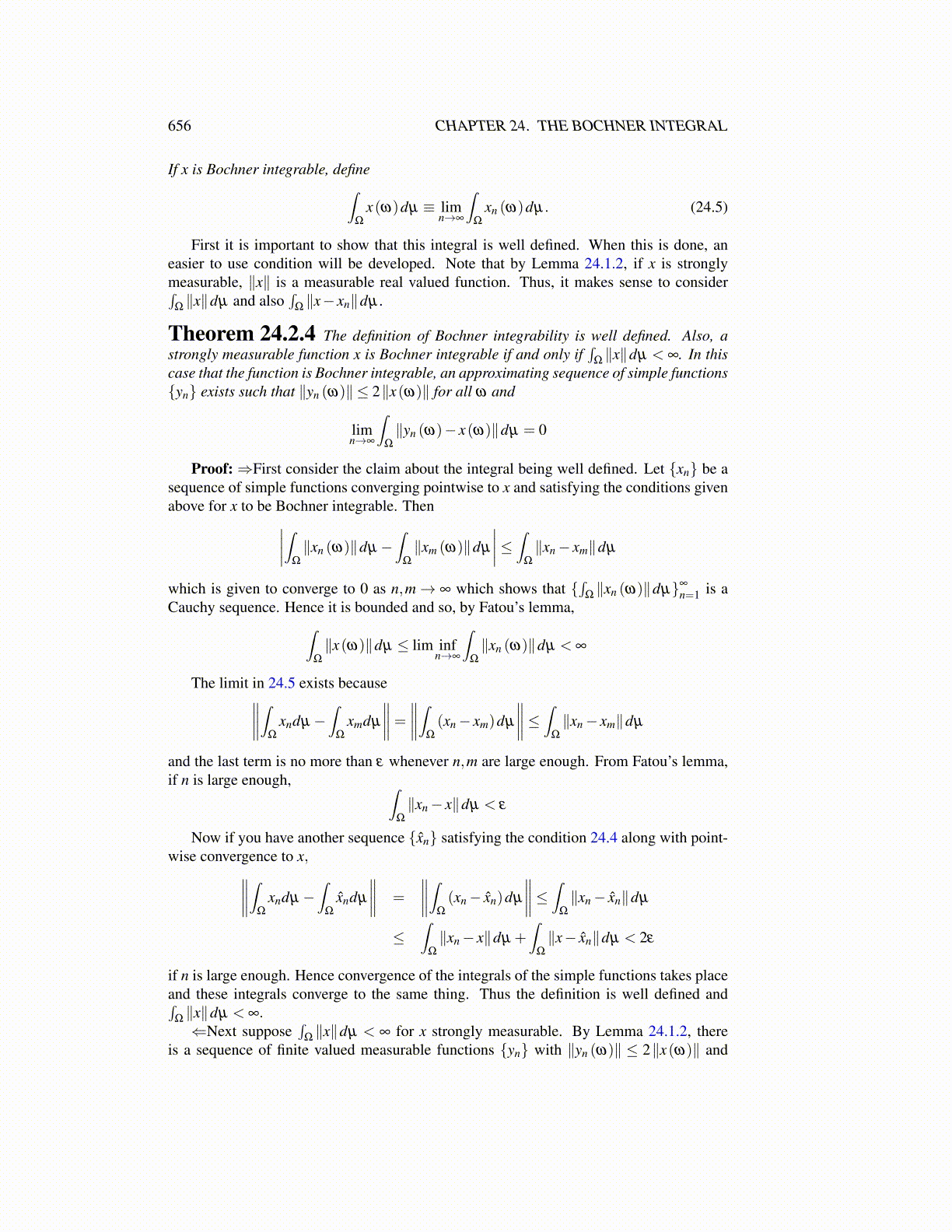
656 CHAPTER 24. THE BOCHNER INTEGRAL
If x is Bochner integrable, define∫Ω
x(ω)dµ ≡ limn→∞
∫Ω
xn (ω)dµ. (24.5)
First it is important to show that this integral is well defined. When this is done, aneasier to use condition will be developed. Note that by Lemma 24.1.2, if x is stronglymeasurable, ∥x∥ is a measurable real valued function. Thus, it makes sense to consider∫
Ω∥x∥dµ and also
∫Ω∥x− xn∥dµ .
Theorem 24.2.4 The definition of Bochner integrability is well defined. Also, astrongly measurable function x is Bochner integrable if and only if
∫Ω∥x∥dµ < ∞. In this
case that the function is Bochner integrable, an approximating sequence of simple functions{yn} exists such that ∥yn (ω)∥ ≤ 2∥x(ω)∥ for all ω and
limn→∞
∫Ω
∥yn (ω)− x(ω)∥dµ = 0
Proof:⇒First consider the claim about the integral being well defined. Let {xn} be asequence of simple functions converging pointwise to x and satisfying the conditions givenabove for x to be Bochner integrable. Then∣∣∣∣∫
Ω
∥xn (ω)∥dµ−∫
Ω
∥xm (ω)∥dµ
∣∣∣∣≤ ∫Ω
∥xn− xm∥dµ
which is given to converge to 0 as n,m→ ∞ which shows that {∫
Ω∥xn (ω)∥dµ}∞
n=1 is aCauchy sequence. Hence it is bounded and so, by Fatou’s lemma,∫
Ω
∥x(ω)∥dµ ≤ lim infn→∞
∫Ω
∥xn (ω)∥dµ < ∞
The limit in 24.5 exists because∥∥∥∥∫Ω
xndµ−∫
Ω
xmdµ
∥∥∥∥= ∥∥∥∥∫Ω
(xn− xm)dµ
∥∥∥∥≤ ∫Ω
∥xn− xm∥dµ
and the last term is no more than ε whenever n,m are large enough. From Fatou’s lemma,if n is large enough, ∫
Ω
∥xn− x∥dµ < ε
Now if you have another sequence {x̂n} satisfying the condition 24.4 along with point-wise convergence to x,∥∥∥∥∫
Ω
xndµ−∫
Ω
x̂ndµ
∥∥∥∥ =
∥∥∥∥∫Ω
(xn− x̂n)dµ
∥∥∥∥≤ ∫Ω
∥xn− x̂n∥dµ
≤∫
Ω
∥xn− x∥dµ +∫
Ω
∥x− x̂n∥dµ < 2ε
if n is large enough. Hence convergence of the integrals of the simple functions takes placeand these integrals converge to the same thing. Thus the definition is well defined and∫
Ω∥x∥dµ < ∞.⇐Next suppose
∫Ω∥x∥dµ < ∞ for x strongly measurable. By Lemma 24.1.2, there
is a sequence of finite valued measurable functions {yn} with ∥yn (ω)∥ ≤ 2∥x(ω)∥ and